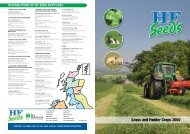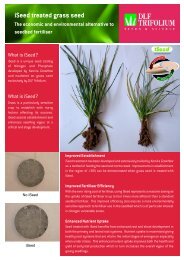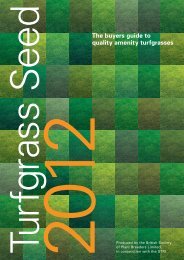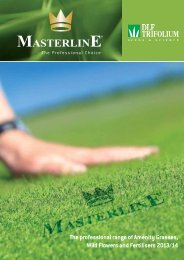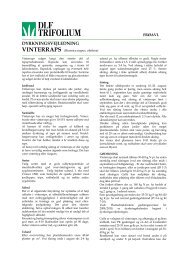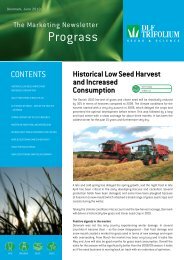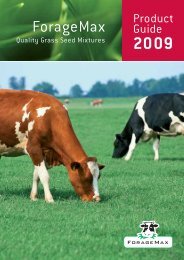You also want an ePaper? Increase the reach of your titles
YUMPU automatically turns print PDFs into web optimized ePapers that Google loves.
<strong>Green</strong> <strong>Manuring</strong> <strong>Crops</strong><br />
INCORPORATION OF GREEN MANURE<br />
With all green manuring crops it is important to make sure that the plant is<br />
incorporated when it is in its most succulent state; in this way the amount of<br />
carbon within the plant structure is very low. Decomposition needs soil nitrogen<br />
to break down carbon, the woodier the plant the greater the carbon content and<br />
hence greater quantities of soil nitrogen are required to break it down. It should<br />
also be borne in mind that the main crop should not be sown too soon after the<br />
green manure has been turned under, since the initial stage of decomposition is<br />
very unfavourable for germination and the growth of young plants. Therefore,<br />
the incorporation and subsequent decay of the green manure or cover crop<br />
should occur at the time it will best serve as fertiliser for the crop it is to benefit.<br />
<strong>Green</strong> <strong>Manuring</strong> can bring many advantages<br />
to the farmer by adding organic matter to the soil,<br />
increasing biological activity, improving soil structure,<br />
reducing erosion, increasing the supply of nutrients<br />
available to plants (particularly by adding nitrogen<br />
to the system by fixation), reducing leaching, weed<br />
suppression and so on. There are some disadvantages<br />
and whilst these are few they should also be noted<br />
- lost opportunities for cash cropping, exacerbated<br />
pest and disease problems (green bridge effect), and<br />
the potential for green manures to become weeds in<br />
their own right. These problems can be overcome<br />
with thought and measured usage, and the benefits to<br />
future crops cannot be dismissed lightly.<br />
<strong>Green</strong> manures not only improve soil status, composition and nutrient balance<br />
but provide a basis for a more environmentally friendly approach to modern<br />
farming. We need to focus our minds on the twin problems of high artificial<br />
fertiliser prices and the soil’s need for basic nutrients with these being available in<br />
a more sustainable form.<br />
A wide range of plant species can be used as green manures. Different<br />
crops bring different benefits and the final choice is influenced by many<br />
considerations. If the most is to be made of green manuring crops, it is<br />
important that they are carefully integrated into the crop rotation and proper<br />
attention paid to their husbandry.<br />
<strong>Green</strong> manures can be categorised as spring sown for summer usage and<br />
autumn sown for over-winter usage, intercropping and longer term fertility<br />
improvement.<br />
Nitrogen (N) in legumes comes from uptake of soil N and the fixation of<br />
N from the atmosphere. The amount of N fixed by different legumes is<br />
determined by the inherent capacity of the crop/rhizobium symbiosis to fix<br />
N, modified by the crop’s growing conditions (e.g. soil, climate, disease), crop<br />
management and length of time for which the crop is grown. Consequently,<br />
the influence of all these factors means that a wide range of values has been<br />
reported by different researchers. The presence of soil mineral N is generally<br />
thought to reduce fixation capacity. Factors that will increase the soil mineral N<br />
pool include manure application, cutting and mulching, and grazing. Fixation<br />
tends to decrease with legume age, mainly because the amount of soil N tends<br />
to increase.<br />
Where growth of legumes is affected by nutrient deficiency (or acidity) the<br />
potential for soil N build up is reduced. Phosphorus, Sulphur and some trace<br />
elements (e.g. Molybdenum) are particularly important. Where there are<br />
large off-takes of soil nutrients as in silage crops both Phosphorus and Potash<br />
supplies need to be adequate for satisfactory legume growth. These should be<br />
replaced as they are essential to the legume to enable it to maximise the fixing<br />
of nitrogen.<br />
FOR SPRING SOWING AND SUMMER<br />
INCORPORATION<br />
Spring sown, summer crops are usually annual crops that as a rule do not tolerate<br />
frost. They are quick growing and will suppress weeds by light deprivation as<br />
well as providing organic material to improve soil structure and organic status.<br />
As they are usually fleshy crops and do not contain high proportions of carbon<br />
when incorporated into the soil, they do not substantially reduce stocks of soil<br />
nitrogen in the breaking down of the plant structure.<br />
AUTUMN SOWING & SPRING<br />
INCORPORATION<br />
Autumn sown crops which go through the winter will scavenge nitrogen from<br />
soils thus preventing “leaching” and can be incorporated in the following<br />
spring, or can provide a source of forage, prior to incorporation. They also help<br />
to control erosion especially on late harvested maize stubbles. Certain species<br />
can be utilised to provide a nitrogen fixer which is then readily available to a<br />
spring sown crop.<br />
LONGER TERM CROPS<br />
Grass and clover leys for long term fertility building must by their nature form<br />
part of the rotation. The increased duration of the sward ensures that the grass<br />
element provides a very strong root system valuable for soil aeration, whilst the<br />
legumes with their deeper root system will improve water filtration through<br />
the soil structure whilst also providing increased soil nitrogen.<br />
DISCLAIMER<br />
The table on the opposite page is given in good faith and intended for general guidance only. Weather, local conditions and crop rotations must always be taken into account.
Crop<br />
Short Term <strong>Crops</strong><br />
White Mustard<br />
Pack<br />
size<br />
5kg &<br />
25kg<br />
Av sowing<br />
rate kg/acre<br />
Treatment<br />
type<br />
Sowing<br />
dates<br />
Incorporation<br />
period<br />
Spring/Summer Sowing & Summer/Autumn Incorporation<br />
5 - 7<br />
Untreated, Cruiser<br />
OSR & Organic<br />
Brown Mustard 5kg 2 - 3 Untreated<br />
Phacelia<br />
1kg &<br />
5kg<br />
3 - 4 Untreated<br />
Buckwheat 5kg 20 - 30 Untreated<br />
Crimson Clover<br />
1kg &<br />
25kg<br />
Spring - Early<br />
Autumn<br />
Spring -<br />
Autumn<br />
Spring -<br />
Summer<br />
Spring -<br />
Summer<br />
8 weeks after<br />
sowing<br />
Autumn - Spring<br />
10 - 12wks after<br />
sowing<br />
Summer - Autumn<br />
5 - 6 Untreated Spring Summer - Autumn<br />
Aslike Clover 25kg 25 Untreated Spring Autumn<br />
Root type/<br />
depth<br />
Fibrous root<br />
system<br />
Tap root<br />
Shallow, fibrous<br />
Shallow, but with<br />
good penetration<br />
Taproot with<br />
fibrous branch<br />
roots<br />
Branched tap root<br />
Deep rooting<br />
Borage 5kg 5+ Untreated Spring Autumn Long tap root.<br />
Over Winter <strong>Crops</strong><br />
Forage Winter<br />
Rye<br />
25kg &<br />
500kg<br />
Italian Ryegrass 25kg 15<br />
Cocksfoot<br />
Forage Rape<br />
15kg -<br />
20kg<br />
5kg &<br />
25kg<br />
Autumn Sowing & Spring Incorporation<br />
50 - 75 Untreated Autumn Spring<br />
2 - 4<br />
2.5 - 4<br />
Vetches 25kg 25 - 35<br />
Longer Term <strong>Crops</strong><br />
Lucerne<br />
Pre-inoculated<br />
White Clover<br />
Red Clover<br />
Yellow Blossom<br />
Clover<br />
Agricultural<br />
Chicory<br />
25kg 8 - 10<br />
1kg &<br />
25kg<br />
1kg &<br />
25kg<br />
2 - 3<br />
5 - 6<br />
Untreated &<br />
Organic<br />
Untreated &<br />
Organic<br />
Untreated, Cruiser<br />
OSR & Organic<br />
Untreated &<br />
Organic<br />
Untreated &<br />
Organic<br />
Untreated &<br />
Organic<br />
Untreated &<br />
Organic<br />
Autumn<br />
Spring /<br />
Autumn<br />
Spring /<br />
Autumn<br />
Spring /<br />
Autumn<br />
Spring - Early<br />
Autumn<br />
Spring - Early<br />
Autumn<br />
Spring - Early<br />
Autumn<br />
Spring<br />
Autumn - Spring<br />
Autumn - Spring<br />
Autumn - Spring<br />
Extensive, fibrous<br />
root system<br />
Extensive, fibrous<br />
root system<br />
Thick and fibrous<br />
with large energy<br />
reserves<br />
Deeply penetrating<br />
tap root.<br />
Tap root<br />
Soil type<br />
All types, best on light,<br />
sandy soils<br />
All types, prefers moist<br />
ground.<br />
Most soil types, will tolerate<br />
dry conditions<br />
Tolerates poor, but not<br />
wet soils<br />
Prefers loam, will tolerate<br />
poor soils as long as alkaline<br />
and free draining.<br />
Most types<br />
Most types, including heavy.<br />
Thrives best on loamy,<br />
calcareous soils.<br />
Grows well on light, sandy,<br />
free-draining soils<br />
Diploids better in wet areas<br />
and tetraploids in drier<br />
Dry, free-draining<br />
Most types, able to tolerate<br />
poor soil & exposed sites<br />
Prefers loams and clay.<br />
Will not thrive in wet or<br />
waterlogged conditions.<br />
Autumn - Spring Very deep tap root Light/chalky/ free-draining<br />
Autumn - Spring<br />
Autumn - Spring<br />
Creeping stolons.<br />
Shallow rooting<br />
Large, strong tap<br />
root<br />
1kg 5 - 6 Untreated Spring Summer - Autumn Long tap root.<br />
1kg &<br />
20kg<br />
3 Untreated<br />
Spring - Early<br />
Autumn<br />
Wide range. Tolerates dry<br />
conditions.<br />
Wide range, avoid poorly<br />
drained, acid soils<br />
Prefers poor soil and dry<br />
conditions. Dislikes wet,<br />
heavy ground.<br />
Autumn - Spring Deep tap root Prefers well drained soils<br />
Useful information and growing tips<br />
Fast growing and good weed supressor. Has biofumigation properties but not to same extent as brown<br />
mustard. Produces large equantities of biomass. Excellent scavenger of nitrogen. Requires fine seedbed.<br />
Susceptible to club root. Plough in before flowering to prevent self-seeding.<br />
As white mustard, but contains high levels of glucosinolate which create biofumigation properties to<br />
reduce wireworm infestation. To maximise this benefit, crop must be finely chopped at flowering and<br />
thoroughly incorporated into moist soil. Brown mustard is winter hardy so is excellent for reducing soil<br />
erosion, water run-off and fertiliser leaching when grown after maize, potatoes & sugar beet.<br />
Quick to establish and a good weed supressor. Flowers loved by bees and butterflies. The crop must be<br />
incorporated into the soil before setting seed or it may reappear in subsequent crops as a weed. Said to<br />
release many minerals into soil as it decomposes, especially P, Ca and Mg.<br />
Fast growing and quick to mature, not winter hardy. Dislikes wet, heavy or compacted soil. Do not allow<br />
to set seed before incorporating into soil. Attractive to beneficial insects especially hoverflies. Good<br />
scavenger of phosphate.<br />
Nitrogen fixing. Very attractive to insects. Excellent weed supressor. Biomass degrades quickly into soil.<br />
Will over-winter in S England for autumn sowing/spring incorporation. Shade tolerant.<br />
Nitrogen fixing. Less biomass than red and white clover but better adapted to wet, acid soils and cooler<br />
conditions. Requires shallow sowing and firm seedbed.<br />
Large leaves and succulent growth provide an abundance of easily broken down material, without<br />
depleting the Nitrogen content of the soil. Royal blue flowers, very attractive to bees.<br />
Produces large amounts of green material. Excellent nitrogen scavenger and for the prevention of nitrate<br />
leaching during winter months. Do not allow to run to seed as this will ‘lock-up’ available nitrogen. Very<br />
hardy. Do not follow too soon with brassica crop or germination will be adversely affected.<br />
As with forage rye, produces high yields of biomass. Good root system for improving soil structure. If seed<br />
heads are produced, crop must be cut before seed is shed to prevent infestation of following crop. Good<br />
‘mopper-up’ of excess soil nitrogen.<br />
When undersown at a low seed rate into winter wheat, cocksfoot is an excellent soil improver for droughtprone<br />
soils.<br />
Fast growing. Good alternative to mustard if using high glucosinolate varieties, as decomposition can<br />
release chemicals which produce a biofumigation effect if incorporated within 24 hours of cutting. Where<br />
club root is a problem, make sure a resistant variety is used.<br />
Nitrogen fixing. Good weed supressor. Ensure winter hardy variety is used. Due to its large seed size, will<br />
establish later than most other legumes. Requires fine, firm seed-bed. As with forage rye, do not follow too<br />
soon with brassica crop or germination will be adversely affected.<br />
Nitrogen fixing. Seed must be inoculated with rhizobium bacteria. Prefers dry growing conditions.<br />
Uncompetitive particularly in early stage of development so grow as pure stand or with non-aggressive<br />
companion grasses.<br />
Nitrogen fixing. Continued defoiation stimulates root growth and nitrogen fixation. Smaller leaved<br />
varieties are more persistent than larger leaved. Good weed supressor. Shallow sow into fine, firm seed bed.<br />
Aggressive, nitrogen fixing plant, does not release N until crop is ploughed in. Shorter term than white<br />
clover. Good for improving and aerating soil structure & useful weed supressor. Ensure fine, firm seed bed.<br />
Biennial. Nitrogen fixing, quick to establish and grows vigorously. Improves soil structure. Plough in before<br />
flowering and before stems becomes woody. Attractive to bees and other insects if allowed to flower.<br />
Biennial plant. Excellent soil improver when grown with cocksfoot and clover, with the resulting<br />
combination of deep, fibrous and nitrogen fixing root systems.





